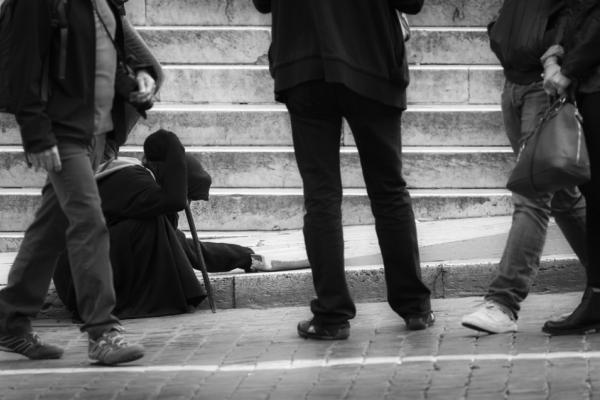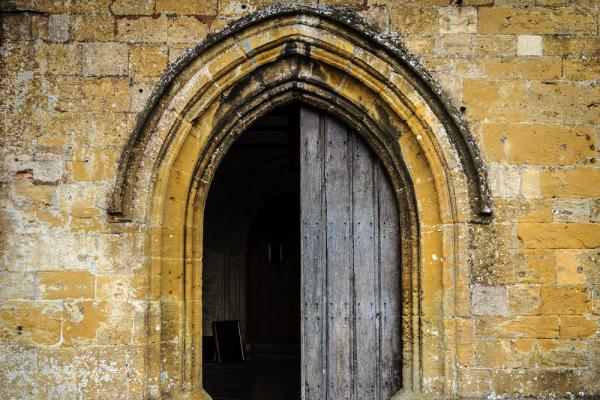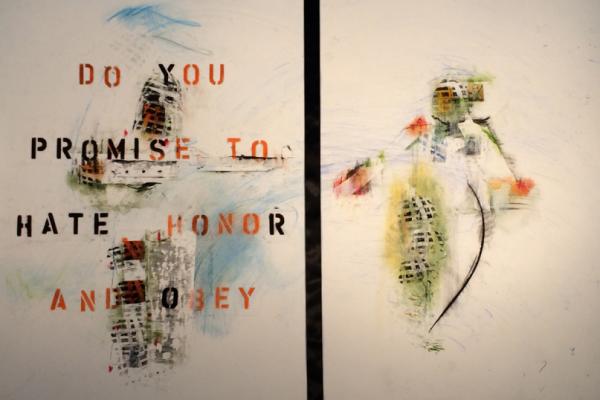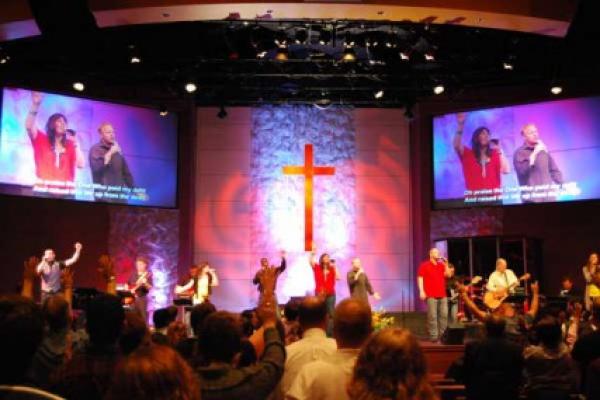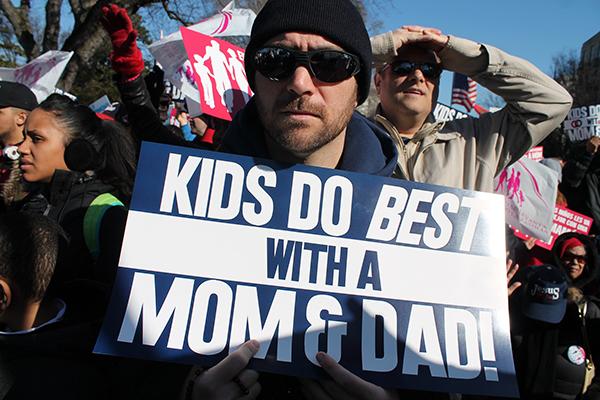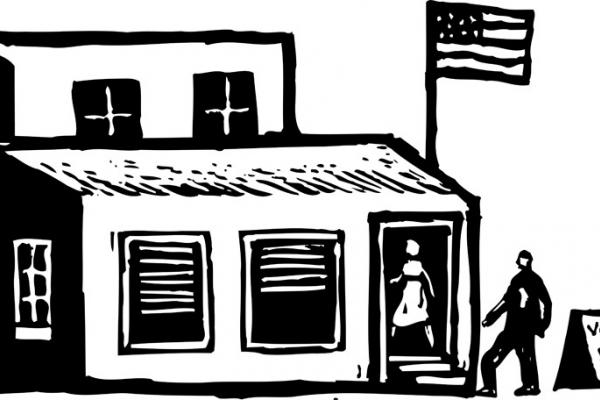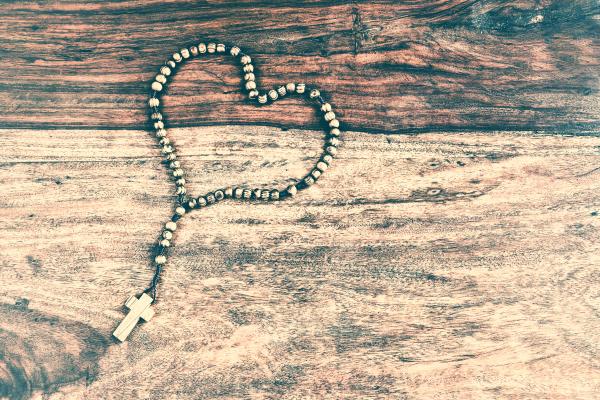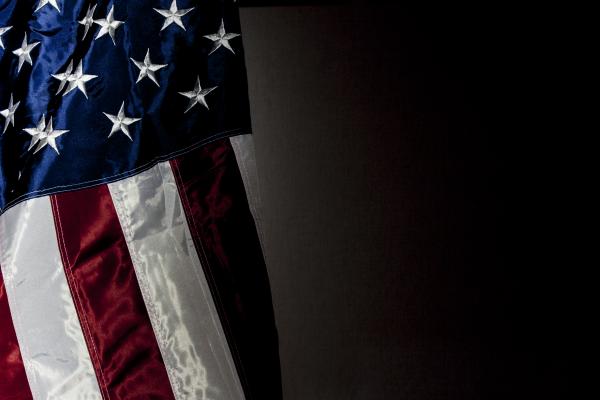“Excuse me, sir. I don’t have any cash, but I have a credit card, and I’m going to that restaurant right now. If you’re hungry, I’d be happy to have you join me.”
Well, I said something like that, though my French was a little rusty, and I might not have said it quite right.
The man was sitting on the sidewalk outside the train station. I’d just arrived in Paris after an overnight ride, and I was tired and hungry. The sign he was holding caught my eye: “I’m an out-of-work architect, and I need money for rent for my son and me.”
You just never know with panhandlers and street beggars. Are they telling the truth, or have they simply figured out how to pull our heartstrings? It’s easy to choose to ignore them, or to toss them some cash and pay off a guilty conscience. Don’t stop, just toss some coins and keep rolling on by. I was living in Madrid at the time, a city of five million people. Beggars are a daily fact of life in a city like that, and you need to find a way to deal with them. Eventually they become like busy intersections, crosswalks, gawking tourists, and all the other impediments to travel.
At the same time, I couldn’t help asking what Christ would do.
Zach Szmara, Pastor of The Bridge Community Church in Logansport, Ind., was on a conference call when a young man entered the church. He put the call on hold to walk out of the office and meet him. In broken English, the man said, "Are you the people that help immigrants?" The man had driven more than 20 miles because he heard rumors of a church that loved the stranger.
Szmara said, "In that moment I was both humbled and convicted. I was humbled that our small church had such a reputation. Yet I was convicted that it was only very recently that I could answer 'yes' to the burning question of this young immigrant who came to me."
"I have lived overseas, and there my eyes could easily see the marginalized and the stranger in my midst. But at home in the states, I almost missed it, and almost missed how God has enriched my life because of it," Szmara continued.
The issue of immigration has dominated the headlines for much of this year. As Christians, we believe that – regardless of where we each may stand on the political spectrum – God’s heart for the immigrant is clear. In fact, the Hebrew word for an immigrant appears 92 times in the Old Testament alone, and the New Testament says in no uncertain terms that however we, as Christians, treat the stranger in our midst, is how we are treating Jesus himself.
While the world’s attention is firmly fixed on the Islamic State’s continued rein of terror, applause for Malala Yousafzai — for taking home the Nobel Peace Prize — has taken on a quieter tone. Yet, her message — that girls can turn the tide against religious radicalism and repression — risks being lost.
In another part of the world, reports continue to trickle in of the failed negotiations between the Nigerian government and Boko Haram — negotiations that were supposed to include provisions for release of the more than 200 Nigerian schoolgirls who remain firmly within Boko Haram’s grip. In fact, there are new reports that another 20 to 70 women and girls have become the latest victims of Boko Haram’s terror, threatening the cease-fire that was to bring the original schoolgirls home. Moreover, much of the world is now eerily silent on the subject — calling into question the commitment to the return of the girls and undermining the separate campaign to improve the education of girls worldwide.
Is this Malala’s world? One where the value of female lives is an open question, and where the kidnapping of girls and women by terrorists goes unanswered? It certainly seems that way. The #bringbackourgirls campaign championed by first lady Michelle Obama and countless Hollywood stars is now a stagnant memory.
Compare this reality to the global push to educate the girls, an understood foundation for economic development and prosperity, with the paradox of the wholesale abandonment of the abducted girls, whose only crime was receiving this exact education.
God bless online media. Almost half of U.S. adults (46 percent) say they saw someone sharing “something about their faith” on the Internet in the last week.
And one in five (20 percent) say they were part of the Internet spiritual action on social networking sites and apps — sharing their beliefs on Facebook, asking for prayer on Twitter, mentioning in a post that they went to church.
“The sheer number of people who have seen faith discussed online is pretty striking,” said Greg Smith, associate director of religion research for Pew Research Center.
Megachurch pastors have mega-followings online. Joel Osteen of Lakewood Church streams his Houston services online. Rick Warren of Saddleback Church has 1.8 million likes on his Facebook page. And Pope Francis has more than 4.6 million English-language followers, chiefly American, for his @Pontifex Twitter feed.
The same-sex marriage movement lost its first major case in a federal appeals court Thursday after a lengthy string of victories, creating a split among the nation’s circuit courts that virtually guarantees review by the U.S. Supreme Court.
The 2-1 ruling from the Cincinnati-based 6th U.S. Circuit Court of Appeals reversed lower court rulings that had struck down gay marriage bans in Michigan, Ohio, Kentucky and Tennessee.
More important, it gives Supreme Court justices an appellate ruling that runs counter to four others from the 4th, 7th, 9th and 10th circuits. Those rulings struck down same-sex marriage bans in Virginia, Indiana, Wisconsin, Oklahoma, Utah, Idaho and Nevada, leading to similar action in neighboring states.
Circuit Judge Jeffrey Sutton, one of the Republican Party’s most esteemed legal thinkers and writers, issued the 42-page decision precisely three months after hearing oral arguments in the cases, with fellow GOP nominee Deborah Cook concurring. He delivered a rare defeat for proponents of same-sex marriage, who had won nearly all the cases decided from Florida to Alaska since the Supreme Court ruled against the federal Defense of Marriage Act in June 2013.
Sutton argued that appellate judges’ hands are tied by a one-sentence Supreme Court ruling from 1972, which “upheld the
right of the people of a state to define marriage as they see it.” Last year’s high court decision requiring the federal government to recognize legal same-sex marriages does not negate the earlier ruling as it applies to states where gay marriage is not legal, he said.
I'll never forget the time I was handed a Voting Guide when I walked into church on Sunday morning.
It was 2008 and I was a 23-year-old single woman, attending a large Southern Baptist congregation in Florida for the very first time.
The high school football coach I'd just written a profile on for the front page of the sports section had recommended I attend his church. He was, I'd ascertained, a good man and a genuine Christian. Plus, he and all the other football coaches from the area attended church here. There was the potential of additional scoops, plus an opportunity to make friends - or more - with some of the younger assistant coaches.
It was an impressive campus, all palm trees and white arches. We sang some familiar music, and to be honest, I don't even remember the sermon.
I remember the seemingly harmless Voters Guide. It was 2008. On the second page, listed in alphabetical order, was the man who would become our nation's first black president.
BARRACK OBAMA
It could've been a simple typo, an auto-correct. But as we were all told to bow our heads and pray for awhile to end abortion, I figured out this little Voters Guide might have a slight political agenda. And perhaps that little agenda might have contributed to them not bothering to spell the Democratic candidate's name correctly.
Much as I would have loved going to the church of the football coaches, I couldn't go back after that.
A friend mentioned that he likes my blogs dealing with love and compassion and other themes without getting into religion specifically. He said that the mention of God can make things uncomfortable.
My reaction: I know exactly where he’s coming from.
The word “God” has become such a loaded term. We’ve made it that way; God hasn’t done it. And the truth is, I’ve found myself shying away from using the word at times because I’m aware it’s an immediate turnoff to some people. They have the same sort of visceral reaction that we get when we see one of those political attack ads come onto our TV set.
We want to reach for the remote and change the channel.
One of the reasons I started writing blogs was to try to strip away some of the nonsense we’ve attached to the name. And there is so much nonsense. You know what I mean:
That God loves me more than you. God approves of me and those who are like me, but not you and those who are like you. God likes my religion and my way of life, but not yours. God is on my side in any disagreement. God approves of hatred and judgment and killing. God promotes crusades and inquisitions and holy wars.
So much …
On Aug. 7 we lit a single white candle at the prayer service welcoming Rosa Robles Loreto into sanctuary at Southside Presbyterian Church in Tucson, Ariz. Almost 90 days later, that candle has been joined by five others, representing Luis Lopez Acabal, Beatriz Santiago Ramirez, Francisco Aguirre, Francisco Perez Cordova, and Arturo Hernandez. We are grateful that Beatriz was just granted a stay so that she could return to her home with her two small children, but the rest all remain in sanctuary.
As we approach Rosa’s 90th day in sanctuary, its time to replace the nearly burned down candle, but the light of radical Christian hospitality continues to not only burn bright, but spread throughout the nation.
In Tuesday’s elections, most voters didn’t see their candidates as leaders. Americans are cynical about politics, exhibited by the broad-based discontent with both parties, the president, and Congress. Nearly two thirds of the electorate didn’t even vote — turnout this year was likely lower as a percentage of the electorate than any time since 1942. Negative campaign ads reached depressing lows, directly appealing to Americans’ fears and anxieties, and most people don’t think the results of the election will change political gridlock in Washington. This election campaign was a loss for the common good.
We seem to have become cynically resigned to politicians always blaming the other party for every problem instead of solving them and alleged political leaders pursuing a 24/7, 52-week strategy of winning instead of governing. There are no more off election years to make society better; every day and every decision is just a part of the next campaign.
The campaigns and the media coverage were all about polls, attacks, and sound bites. The Republican campaign message was simply: vote against President Obama. And the Democrats deserted him, wouldn’t discuss either his accomplishments or his failures, and had no message of their own that got through. The campaign wasn’t about the most important issues facing the country. Here’s what we should be talking about.
While much of the country was receiving election returns and news of a red tide sweeping across the nation, here in Oregon we have more of a white, black, and brown problem.
One way to look at Oregon was that the “progressive” blues all won — our Democratic incumbents were all re-elected for U.S. Congress and governor, and statewide measures to legalize the sale and use of recreational marijuana sailed to an easy victory.
So, from a distance it looks like the dream of the Bill Clinton 90s is still alive in Portland.
I’ve been here more than a year now, planting a church and beginning to work with neighborhood partners, and have come to realize that the dream for truly “progressive” values — like immigration reform and bridging the gap in ever increasing income inequalities — is more like a bad dream that won’t go away.
